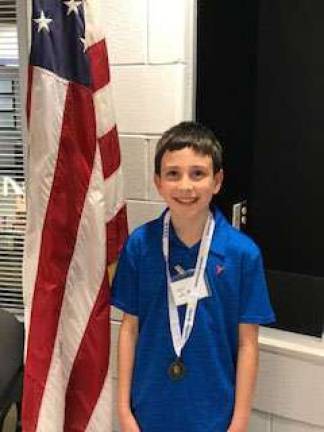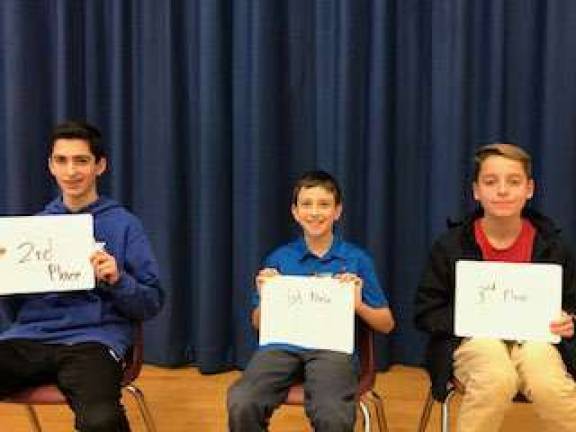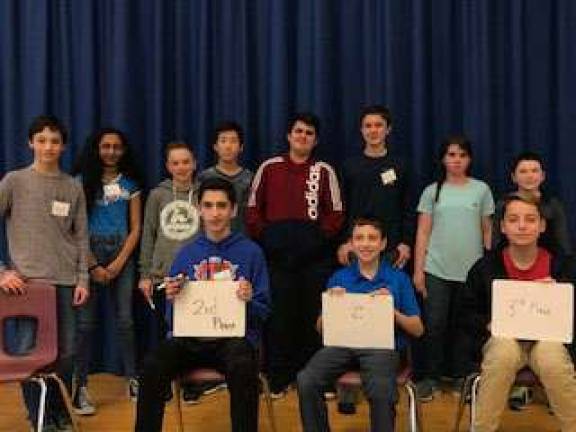Sparta 6th grader advances in geography bee



By Rose Sgarlato
SPARTA — Ian Bellush, a sixth grade student at Sparta Middle School, won the school competition of the 30th Annual National Geographic Bee and a chance to win a $50,000 college scholarship.
The event took place on Jan. 12 at the middle school where the top ten students from the preliminary Bee answered questions on geography to compete for the title of School Bee Champion: Landon Tanyeri, Cody Ryersen, Ian Bellush, Rachael Berghahn, Luke Johnston, Andy Stefancik, Kavya Kamath, Jack Budofsky, Colin Kowalski, and Hayden Budofsky.
Cody Ryerson, Hayden Budofsky and Ian Bellush took the top three spots. The audience for the Bee was made up of students with scores in the top ten percentile of the preliminaries, each of whom received a certificate for their achievement.
“It was an inspiring competition, and all participants should be proud of their knowledge and performance,” said Cherie Shefferman, Gifted & Talented/Digital Life teacher.
According to a release from National Geographic, the competition is designed to inspire and reward students’ curiosity about the world.
“Thousands of schools around the United States and in the five U.S. territories are participating in the 2018 National Geographic Bee," the society said. "The school champions will take a qualifying test. Up to 100 of the top scorers on that test in each state will then be eligible to compete in their state Bee on April 6, 2018.”
Ian Bellush will be taking that next step on April 6. All state winners will be eligible for the national championship rounds on May 20-23 in Washington D.C.; all expenses will be paid by National Geographic.
The first- place national champion will receive a $50,000 college scholarship, a lifetime membership in the society including a subscription to National Geographic magazine and an all-expenses-paid Lindblad expedition to the Galápagos Islands aboard the new National Geographic Endeavour ll. Second- and third-place finishers will receive $25,000 and $10,000 college scholarships respectively.
Developed in 1989, The National Geographic Society created the Bee in response to concern about the lack of geographic knowledge among young people in the United States. The organization provided the following information:
“Over three decades, 1,583 state champions have traveled to D.C. to participate in the finals, and the National Geographic Society has awarded more than $1.5 million in college scholarship money to winners of the competition. “
The final round of the National Geographic Bee Championship in May 2018 will air later on local public television stations. In the interim, here are some sample questions that National Geographic supplied:
1. The Appalachian Mountains run through which state—Georgia or Mississippi? A. Georgia
2. The North Platte and South Platte Rivers meet in which state—New Mexico or Nebraska? A. Nebraska
3. Which state straddles the Tropic of Cancer—Hawaii or Alaska? A. Hawaii
4. Which form of mass production was used by Henry Ford to produce automobiles in large quantities in Detroit, Michigan—threshing machine or assembly line? A. assembly line
5. What is the term for the physical location where a plant or animal lives—habitat or pattern? A. habitat
6. Which country does not contain large areas of desert—Chad, Venezuela, or Iraq? A. Venezuela
7. Public steam baths called hammams are part of the culture in cities such as Casablanca and Marrakech in which African country? A. Morocco
8. The Delmarva Peninsula includes parts of Delaware, Virginia, and which other state? A. Maryland
9. The easternmost part on the Horn of Africa is located in which country? A. Somalia
10. Angkor Wat, built as a tribute to Hinduism, is located in which Southeast Asian country where Buddhism now predominates? A. Cambodia
For more geography knowledge try Geo Bee Quiz, an online geography quiz at www.nationalgeographic.org/bee/study/quiz. In honor of the 30th anniversary of the Bee, National Geographic has also published an updated book: “How to Ace the National Geographic Bee: Official Study Guide, 5th Edition,” by Stephen Cunha.
The National Geographic Society is a leading nonprofit that invests in bold people and transformative ideas in the fields of exploration, scientific research, storytelling and education. Through our grants and programs, we aspire to create a community of change, advancing key insights about our planet and probing some of the most pressing scientific questions of our time while ensuring that the next generation is armed with geographic knowledge and global understanding. For more information, visit <URL destination="http://www.nationalgeographic.org. ">www.nationalgeographic.org.